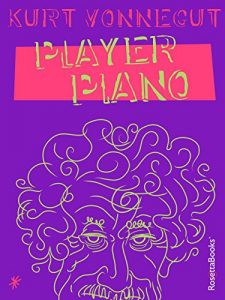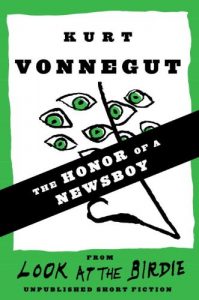Player Piano (1952), Vonnegut’s first novel, embeds and foreshadows themes which are to be parsed and dramatized by academians for centuries to come. His future society--a marginal extrapolation, Vonnegut wrote, of the situation he observed as an employee of General Electric in which machines were replacing people increasingly and without any regard for their fate--is mechanistic and cruel, indifferent to human consequence, almost in a state of merriment as human wreckage accumulates. Paul Proteus, the novel’s protagonist, is an engineer at Ilium Works and first observes with horror and then struggles to reverse the displacement of human labor by machines.
Ilium Works and Paul’s struggles are a deliberately cartoon version of labor’s historic and escalating struggle to give dignity and purpose to workers. The novel embodies all of Vonenegut’s concerns and what he takes to be the great dilemma of the technologically overpowered century: the spiritual needs of the population in no way serve the economies of technology and post-technology. Vonnegut overlies this grotesque comedy over tragedy, disguising his novel in the trappings of goofiness.
Not published--at Vonnegut’s insistence--as science fiction, the novel was nonetheless recognized and praised by the science fiction community which understood it far better than a more general readership, a dilemma which Vonnegut resentfully faced throughout his career. Bernard Wolfe’s dystopian Limbo and Player Pianowere published in the same year to roughly similar receptions; two “outsiders” had apotheosized technophobia as forcefully as any writer within the field. Throughout his career, Vonnegut was forced to struggle with his ambivalence about science fiction and his own equivocal relationship with its readers.
ABOUT THE AUTHOR
Kurt Vonnegut (1922-2007) is one of the most beloved American writers of the twentieth century. Vonnegut's audience increased steadily since his first five pieces in the 1950s and grew from there. His 1968 novel Slaughterhouse-Five has become a canonic war novel with Joseph Heller's Catch-22 to form the truest and darkest of what came from World War II.
Vonnegut began his career as a science fiction writer, and his early novels--Player Piano and The Sirens of Titan--were categorized as such even as they appealed to an audience far beyond the reach of the category. In the 1960s, Vonnegut became closely associated with the Baby Boomer generation, a writer on that side, so to speak.
Now that Vonnegut's work has been studied as a large body of work, it has been more deeply understood and unified. There is a consistency to his satirical insight, humor and anger which makes his work so synergistic. It seems clear that the more of Vonnegut's work you read, the more it resonates and the more you wish to read. Scholars believe that Vonnegut's reputation (like Mark Twain's) will grow steadily through the decades as his work continues to increase in relevance and new connections are formed, new insights made.
ABOUT THE SERIES
Author Kurt Vonnegut is considered by most to be one of the most important writers of the twentieth century. His books Slaughterhouse-Five (named after Vonnegut's World War II POW experience) and Cat's Cradle are considered among his top works. RosettaBooks offers here a complete range of Vonnegut's work, including his first novel (Player Piano, 1952) for readers familiar with Vonnegut's work as well as newcomers.
Ilium Works and Paul’s struggles are a deliberately cartoon version of labor’s historic and escalating struggle to give dignity and purpose to workers. The novel embodies all of Vonenegut’s concerns and what he takes to be the great dilemma of the technologically overpowered century: the spiritual needs of the population in no way serve the economies of technology and post-technology. Vonnegut overlies this grotesque comedy over tragedy, disguising his novel in the trappings of goofiness.
Not published--at Vonnegut’s insistence--as science fiction, the novel was nonetheless recognized and praised by the science fiction community which understood it far better than a more general readership, a dilemma which Vonnegut resentfully faced throughout his career. Bernard Wolfe’s dystopian Limbo and Player Pianowere published in the same year to roughly similar receptions; two “outsiders” had apotheosized technophobia as forcefully as any writer within the field. Throughout his career, Vonnegut was forced to struggle with his ambivalence about science fiction and his own equivocal relationship with its readers.
ABOUT THE AUTHOR
Kurt Vonnegut (1922-2007) is one of the most beloved American writers of the twentieth century. Vonnegut's audience increased steadily since his first five pieces in the 1950s and grew from there. His 1968 novel Slaughterhouse-Five has become a canonic war novel with Joseph Heller's Catch-22 to form the truest and darkest of what came from World War II.
Vonnegut began his career as a science fiction writer, and his early novels--Player Piano and The Sirens of Titan--were categorized as such even as they appealed to an audience far beyond the reach of the category. In the 1960s, Vonnegut became closely associated with the Baby Boomer generation, a writer on that side, so to speak.
Now that Vonnegut's work has been studied as a large body of work, it has been more deeply understood and unified. There is a consistency to his satirical insight, humor and anger which makes his work so synergistic. It seems clear that the more of Vonnegut's work you read, the more it resonates and the more you wish to read. Scholars believe that Vonnegut's reputation (like Mark Twain's) will grow steadily through the decades as his work continues to increase in relevance and new connections are formed, new insights made.
ABOUT THE SERIES
Author Kurt Vonnegut is considered by most to be one of the most important writers of the twentieth century. His books Slaughterhouse-Five (named after Vonnegut's World War II POW experience) and Cat's Cradle are considered among his top works. RosettaBooks offers here a complete range of Vonnegut's work, including his first novel (Player Piano, 1952) for readers familiar with Vonnegut's work as well as newcomers.












